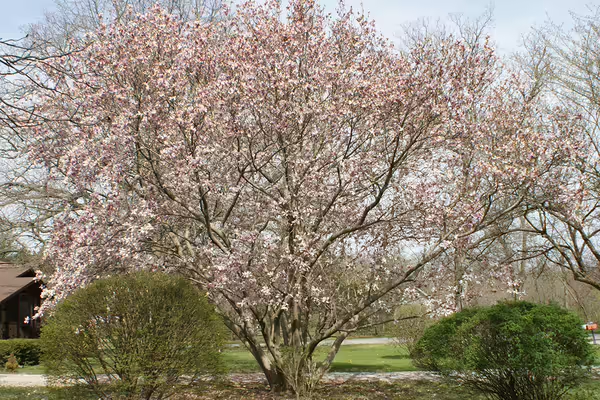
URBANA, Ill. – Every spring, magnolia trees across the Midwestern landscape offer some of the most spectacular flowering displays of any woody plant. These beautiful ornamental trees, native to Asia, are some of the first landscape plants in our area to deliver such a showy display; truly one of the most endorsing signs that spring is finally here.
Most of Illinois’ native, deciduous trees are primarily wind pollinated and many bloom even earlier than magnolias, although often unnoticed by many of us says University of Illinois Extension horticulture educator Ryan Pankau. Their strategy is to produce a lot of pollen in the hopes that wind dispersion will spread their genes far and wide. Wind pollinated species do not need a showy display to attract pollinating animals or human attention. They typically lack aroma and nectar which, along with color, are the primary means plants use to attract pollinators to their flowers.
“Since most of our native trees, like oak, ash, and maple, evolved flowers for wind pollination, they are largely unnoticed during flowering,” Pankau says.
Their smaller, low-key flowers are not designed to be colorful or attractive, but rather to allow tons of pollen to freely float away on the wind. Their pollen producing structures, called anthers, are often loosely attached, and hang down to dangle in the wind.
Magnolias evolved a different strategy for pollination. Their flowers are quite showy, produce nectar, and have fragrance, all in the effort to attract insects. They invest more energy in these insect-attracting traits than pollen production, generating much less pollen per flower than their wind-pollinated cousins.
The interesting twist with magnolias is that their genus Magnoliais quite ancient, evolving very early in the plant family tree, earlier than our native flowering trees. They are considered to be among the oldest of the flowering plants.
“At the time of their evolution, many common pollinators we think of today, such as bees, butterflies, and moths had not evolved yet,” Pankau says. “As a result, magnolias developed flowers for pollination by beetles and flies, which were the primary insect pollinators 100 million years ago.”
Magnolia flowers are relatively simple when compared to other, more specialized flowers. Pollen structures are arranged so that insects searching for a nectar reward will haphazardly bump into them and subsequently spread pollen as they amble from flower to flower.
Flightless beetles were the primary constituents of magnolia flowers millions of years ago as they evolved and are often considered “dumb pollinators.” These poor insects get a bad rap because they cannot perform more advanced behaviors of butterflies and other pollinators that evolved later as the plant-pollinator relationship became more complex. Butterflies and other “smarter” pollinators can perform advanced tasks, such as extraordinary feats of flower manipulation, to harvest pollen.
The lowly beetle, which receives a ton of credit for the early development of magnolia flowers, is left to dumbly wander from flower to flower. The process of co-evolution between flowering plants and insects is considered one of the most intricate multi-species evolutionary processes on earth. When plants evolved flowers, it was a game-changer for plant reproduction. So, there is no reason to totally discount beetles as “dumb” since magnolia flowers would not be possible without these grunts of the pollinator world.
Consequently, magnolias evolved to accommodate their “less educated” pollinators with some specially tailored adaptations. Beetle mouthparts are made primarily for chewing, not pollen collection from delicate flower parts. Thus, other plant parts are often consumed in the process of harvesting pollen or nectar from the flowers.
“Magnolia flowers have leathery, thick leaves along with seeds that are well protected to handle this kind of sloppiness,” Pankau says.
Magnolias and their beetle friends are certainly an odd couple in the plant and insect world. However, their relationship has worked out wonderfully to produce some of our most exquisite flowering ornamental trees.
SOURCE: Ryan Pankau, Horticulture Educator, Illinois Extension.
ABOUT EXTENSION: Illinois Extension, the public outreach and engagement arm of the University of Illinois, translates research-based knowledge into actionable insights and strategies that enable Illinois businesses, families, and community leaders to solve problems, adapt to changes and opportunities, make informed decisions, and carry technical advancements forward into practice.
PHOTO ACCESS: The photo in this article is available to download for media use.
Photo by Ryan Pankau. Saucer magnolia, Magnolia x soulangeana, in full bloom, with an abundance of white to pinkish, showy flowers.